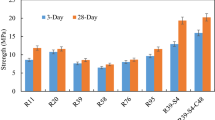Abstract
A novel pyrometallurgical process for the synthesis of porous forsterite by calcination in chlorine of a mixture containing hydromagnesite and silica gel was developed. The aim of this work was to produce porous forsterite at low temperatures and short reaction times. Effects of temperature, reaction time and chlorine on the synthesis reaction were studied. Also, the reaction mechanism involved in the process was investigated. Isothermal and non-isothermal chlorination assays were carried out in a thermogravimetric equipment designed to work in corrosive atmospheres. Reagents and products were analyzed by thermogravimetry (TG) and X-ray diffraction (XRD), scanning electron microscopy (SEM) and N2 adsorption–desorption isotherm (BET). The results showed that forsterite was obtained at 700 \(^{\circ }\)C with a mesoporous structure and a specific surface area of 16.8 m2/g. Furthermore, it was observed that the presence of chlorine favored the decomposition of hydromagnesite.
Similar content being viewed by others
References
Tavangarian F, Emadi R (2010) Synthesis of nanocrystalline forsterite (Mg2SiO4) powder by combined mechanical activation and thermal. Mater Res Bull 45:388–391
Barzegar Bafrooei H, Ebadzadeh T, Majidian H (2014) Microwave synthesis and sintering of forsterite nanopowder produced by high energy ball. Ceram Int 40:2869–2876
Chena L, Yea G, Wanga Q, Blanpainb B, Malflietb A, Guob M (2015) Low temperature synthesis of forsterite from hydromagnesite and fumed silica mixture. Ceram Int 41: 2234–2239
Ramesh S, Yaghoubi A, Sara Lee KY, Christopher Chin KM, Hassan MA, Purbolaksono J, Hamdi M (2013) Nanocrystalline forsterite for biomedical applications: synthesis, microstructure and mechanical properties. J Mech Behav Biomed Mater 25:63–69
Sadeghzade S, Emadi R, Tavangarian F, Naderi M (2017) Fabrication and evaluation of silica-based ceramic scaffolds for hard tissue engineering applications. Mater Sci Eng C 71:431–438
Wahsh MMS, Khattab RM, Khalil NM, Gouraud F, Huger M, Chotard T (2014) Fabrication and technological properties of nanoporous spinel/forsterite/zirconia ceramic composites. Mater Design 53:561–567
Khattab RM, Wahsh MMS, Khalil NM (2015) Ceramic compositions based on nano forsterite/nano magnesium aluminate spinel powders. Mater Chem Phys 166:82–86
Saidi R, Fathi M, Salimijazi H (2017) Synthesis and characterization of bioactive glass coated forsterite scaffold for tissue engineering applications. J Alloys Compd 727:956–962
Saidi R, Fathi M, Salimijazi H, Mohammadrezaie M (2017) Fabrication and characterization nanostructured forsterite foams with high compressive strength, desired porosity and suitable bioactivity for biomedical applications. J Sol-Gel Sci Technol 81:734–740
Choudhary R, Manohar P, Vecstaudza J, Yáñez-Gascón MJ, Swamiappan S (2017) Preparation of nanocrystalline forsterite by combustion of different fuels and their comparative in-vitro bioactivity, dissolution behaviour and antibacterial studies. Mater Sci Eng C 77:811–822
Choudhary R, Chatterjee A, Venkatraman SK, Koppala S, Swamiappan S (2018) Antibacterial forsterite (Mg2SiO4) scaffold: a promising bioceramic for load bearing applications. Bioact Mater 3:218–224
Orosco P, Ruiz MDC, González J (2013) Phase transformations of a talc ore under heated chlorine atmosphere. Thermochim Acta 554:15–24
Orosco P, Barbosa L, Ruiz MDC (2014) Synthesis of magnesium aluminate spinel by periclase and alumina chlorination. Mater Res Bull 59:337–340
Orosco P, Ruiz MDC, González J (2014) Synthesis of cordierite by dolomite and kaolinitic clay chlorination. Study of the phase transformations and reaction mechanism. Powder Technol 267:111–118
Túnez FM, González J, Ruiz MDC (2007) Aparato de Laboratorio para Realizar Termogravimetrías en Atmósferas Corrosivas y no Corrosivas, P060100450
Todor DN (1976) Thermal analysis of minerals. Abacus Press, Tunbridge Wells
Hollingberya LA, Hullb TR (2010) The thermal decomposition of huntite and hydromagnesite—A review. Thermochim Acta 20: 1–11
Acknowledgments
The authors wish to thank Universidad Nacional de San Luis (UNSL) and Consejo Nacional de Investigaciones Científicas y Técnicas (CONICET) for financial support.
Author information
Authors and Affiliations
Corresponding author
Rights and permissions
About this article
Cite this article
Orosco, R.P., Ojeda, M.W., González, J.A. et al. Thermogravimetric Study of Porous Forsterite Synthesis by Hydromagnesite and Silica Gel Chlorination. Silicon 11, 1413–1419 (2019). https://doi.org/10.1007/s12633-018-9945-6
Received:
Accepted:
Published:
Issue Date:
DOI: https://doi.org/10.1007/s12633-018-9945-6




